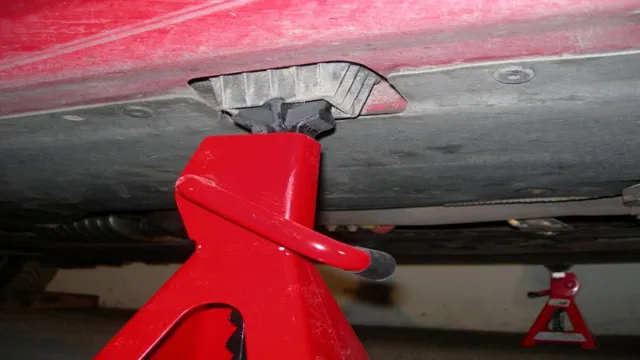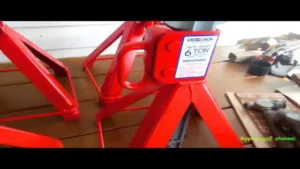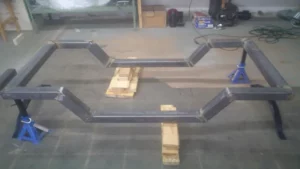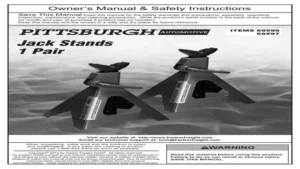Few things can be as daunting for a DIY mechanic as the prospect of getting their car off the ground. If you’re a BMW owner, you’ll want to make sure you have a plan before getting started so you can take care of tasks like changing oil, brakes, or suspension. But how do you put your BMW on jack stands? It can seem intimidating, but it’s a straightforward process with the right tools and knowledge.
In this blog post, we’ll cover all the steps you need to know to get your BMW safely elevated and ready for work. By the end of it, you’ll know how to jack up your vehicle and support it properly, so you can get to work with confidence. So without any further ado, let’s get rolling!
Gather Your Tools and Supplies
When it comes to putting your BMW on jack stands, it’s important to have the right tools and supplies. The first and most obvious thing you’ll need is a good set of jack stands. You’ll also need a jack, either hydraulic or scissor, depending on your preference.
A wheel chock is useful for keeping your vehicle from moving while it’s in the air. You’ll also want to have a lug wrench or breaker bar to loosen and tighten your lug nuts. Additionally, consider having a torque wrench on hand to properly tighten your lug nuts to prevent the wheels from falling off.
Lastly, it’s important to wear safety gear such as protective eyewear and gloves to prevent injuries. Having all of these tools and supplies at the ready will make the process of putting your BMW on jack stands much smoother and safer.
Jack Stands
When it comes to using jack stands, it’s important to gather all the necessary tools and supplies beforehand. You’ll need a jack to lift your car up, of course, but you should also have a pair of jack stands ready to go. It’s essential to use both jack and stands correctly and ensure that the vehicle is secure.
Additionally, make sure you’re working on a level surface, wear appropriate safety gear such as eye protection and thick gloves, and keep a fire extinguisher nearby in case of an emergency. As for the jack stands themselves, you can choose from a variety of materials and weight capacities. Make sure to select the appropriate stands for your vehicle based on its weight and the intended use.
By taking these steps and gathering the necessary tools and supplies ahead of time, you’ll be well-prepared to safely use jack stands and perform work on your vehicle.

Floor Jack
Floor Jack One of the most important aspects of using a floor jack is gathering all the necessary tools and supplies beforehand. This will not only make the job easier but also prevent any delays or mistakes. You’ll need a decent floor jack, jack stands, wheel chocks, gloves, and a hydraulic fluid (if required).
Make sure that your floor jack is rated for the weight of your vehicle. The last thing you want is for your car to collapse while you’re working under it. Jack stands are also crucial for safety purposes.
They prevent the car from tipping over while it’s in the air and support it while you work on it. Wheel chocks are also important to prevent the car from rolling while it’s being lifted. Gloves protect your hands from any sharp edges or dirty components.
And finally, check the hydraulic fluid level in your floor jack to ensure smooth operation. With all the tools and supplies ready, you’re now prepared to use your floor jack with confidence and safety.
Wheel Chocks
Wheel chocks are essential safety accessories for anyone working with vehicles. Before you start the task, gather your tools and supplies, including the wheel chocks, to ensure that you have everything you need. You’ll need a few other things, too, such as gloves, protective eyewear, and appropriate work clothes, depending on the task at hand.
Once you have everything you need, select the correct size and type of chock for the job. The most common types are wedge and block shaped, made from materials like rubber, steel, and plastic. Consider the weight of the vehicle and the terrain it’s parked on to choose chocks that can handle the load and won’t slip.
Use the chocks beneath the wheels of the vehicle to prevent accidental movement, and ensure the wheels are centered on the chocks to prevent them from rolling off. By taking the time to gather your tools, select the correct chocks, and use them properly, you’ll help prevent accidents and keep yourself and others safe. Remember, safety always comes first!
Find a Suitable Location
Before even attempting to put a BMW on jack stands, it’s important to find a suitable location to work on the car. You’ll need space, a flat surface, and good lighting. Ideally, you’ll want to work in a garage or carport, but if that isn’t possible, try to find a level area away from traffic and pedestrians.
It’s also important to consider the surface on which you’ll be placing the jack stands. Concrete or asphalt are the best options, but if you must work on gravel or dirt, place a sturdy board or mat underneath the jack stands to provide stability. Once you’ve found an appropriate location, park the car and engage the parking brake before proceeding with putting the BMW on jack stands.
By taking the time to find a suitable location, you can ensure that you’ll be safe while working on your car and minimize the risk of any accidents or damage.
Level Surface
When it comes to finding a suitable location for a level surface, there are a few things to consider. First and foremost, the surface should be as flat as possible, without any significant bumps or dips that could affect the levelness of the surface. Additionally, it’s essential to ensure that the ground is stable, and there are no underlying issues such as soft soil or rocks that could shift over time.
It’s also important to consider the surrounding environment, such as nearby trees or buildings that could cause shade or block the wind, affecting the levelness of the surface. Lastly, it’s important to think about your intended use for the level surface. Will it be for recreational activities such as sports or simply as a place to relax and enjoy the outdoors? Whatever the case may be, taking the time to find the right location with a level surface will pay off in the long run.
Safe Distance
When it comes to finding a suitable location for safe distance, there are a few things to keep in mind. First, consider the amount of foot traffic in the area. It’s best to avoid crowded places and areas with high foot traffic, as it increases the risk of exposure.
You should also be mindful of the environment itself – open and well-ventilated areas are preferred, as airflow can help dissipate any viral particles in the air. If you’re indoors, look for spaces with high ceilings, ventilation, and windows that can be opened to allow fresh air in. Additionally, it’s important to consider the distance between yourself and other people – try to maintain a distance of at least six feet at all times.
This may mean choosing a larger outdoor space or finding an indoor location with enough room to spread out. By carefully considering these factors, you can find a location that will help ensure you stay safe and healthy, even in challenging times.
Prepare Your BMW
Putting your BMW on jack stands is a simple but vital task that every car owner should know how to do. First, locate the jacking points under your BMW. This information can be found in your car’s manual or online.
Once you’ve found the jacking points, place the jack stands under them and adjust the height of the stands to slightly below the car’s chassis. Make sure the jack stands are positioned securely and the car is stable before you begin any work on it. Be sure to remove the jack before you start working and use wheel chocks to secure the car’s wheels.
By following these steps, you can elevate your BMW safely and confidently for any necessary maintenance or repairs. As always, safety first!
Engage Emergency Brake
As a BMW owner, it’s crucial to know how to properly prepare your vehicle before driving. One essential step is engaging the emergency brake. This is especially important when parking on a hill or incline, as it helps prevent your car from rolling forward or backward.
To engage the emergency brake, simply press down on the brake pedal and pull up on the brake lever. Ensure that the lever is fully engaged before releasing the brake pedal. It’s better to be safe than sorry, so take the extra few seconds to engage the emergency brake for added security.
By doing so, you can have peace of mind knowing that your BMW won’t move while parked.
Place Wheel Chocks
Before preparing your BMW for maintenance or repair work, it is essential to place wheel chocks to prevent the vehicle from moving. Wheel chocks are small blocks designed to keep the wheels from rolling, providing added stability and safety while you work. Without wheel chocks, your BMW may move unexpectedly, causing damage to the vehicle or injury to yourself or others.
To properly place wheel chocks, park your BMW on level ground and place a chock behind each wheel that is not being lifted. Make sure the chocks fit snugly against the tires and are flush with the ground. Once the chocks are in place, you can proceed with preparing your BMW for maintenance or repair work.
Taking a few extra precautions like placing wheel chocks can prevent potentially costly and dangerous mishaps, so don’t skip this important step!
Loosen Lug Nuts
To prepare your BMW for any upcoming travel, it’s important to keep your lug nuts in mind. Before getting started, make sure you have a sturdy lug wrench and a jack stand. Loosening the lug nuts can be tricky if they are tight.
Start the process by Positioning the wrench over the first lug nut, and apply upward pressure with your foot on the wrench handle. If the nut is difficult to turn, try hitting the wrench with a rubber mallet or try spraying some lubricant. It’s imperative to ensure that every nut is completely unscrewed rather than loosened.
Once all the lug nuts are loosened, you can proceed to lift the car with the jack stand and fully remove the lug nuts and wheels. Taking these precautions and following the right protocol not only enlists your safety but also ensures that you enjoy your road trip free from car troubles.
Jack Up BMW
Putting your BMW on jack stands may seem like a daunting task, but it’s actually quite simple once you know the proper steps. First, securely park your BMW on a level surface and engage the emergency brake. Then, locate the designated jack points on your BMW (usually located behind the front wheels and in front of the rear wheels) and place the jack stands under them.
Slowly raise your BMW using the jack until it’s high enough to slide the jack stands under. Once the jack stands are properly positioned and securely in place, you can slowly lower your BMW onto them and ensure they’re holding the weight of the car. Be sure to double-check that the jack stands are secure and stable before working on your BMW.
With these simple steps and the proper safety precautions, you’ll be able to safely jack up your BMW without any issues.
Position Floor Jack
When it comes to jacking up your BMW, safety should always be a top priority. Before starting, make sure the surface you’re working on is level, and that the jack you’re using is appropriate for your vehicle. Position the floor jack under the designated jacking point, which can often be found in the owner’s manual or on a sticker under the car.
Once the jack is in place, slowly raise it until it’s touching the designated point. Be sure to double-check that the jack is securely in place before proceeding with any work. Remember, taking the time to properly position and secure the jack could prevent a serious accident.
So, take your time and proceed with caution.
Jack Up BMW
Are you planning to jack up your BMW? If so, there are a few important things to keep in mind before diving in. First and foremost, safety should be your top priority. Make sure you have the necessary equipment, including a heavy-duty jack and jack stands.
It’s also important to thoroughly inspect the area where you plan to jack up your car and ensure it’s on level ground. Once you’ve taken the necessary precautions, find the designated jacking points for your specific BMW model. These points are there to provide maximum stability and safety while jacking up your car.
Remember to always lift the car slowly and carefully, and only jack it up to the necessary height. Don’t forget to use caution when re-positioning the jack stands as well. Whether you’re changing tires, performing maintenance, or simply showing off your car, jacking up your BMW can be a fun and rewarding experience.
Just be sure to take the necessary precautions and always prioritize safety.
Place Jack Stands
If you’re planning to jack up your BMW, it’s essential to place jack stands before you get started. Jack stands are crucial for stability and safety because they can prevent your car from falling to the ground in case the jack fails. If you’re new to the process, it’s important to note that jacking up your BMW can be dangerous if not done correctly.
So, before you begin, ensure your car is on a leveled surface, apply the brakes, and turn off the engine. Then, find the designated jack points for your BMW. Typically, these are marked underneath the car, but you can refer to your owner’s manual to be sure.
Carefully position your jack stand underneath the designated jacking point, ensure it’s securely in place, and begin to raise your car. Once your BMW is in the air, slowly lower it onto your jack stands, making sure it’s stable before you continue. Overall, by following these steps, you’ll be able to jack up your BMW safely and securely every time.
Lower BMW onto Jack Stands
Before getting started with jacking up your BMW, the first thing you’ll need to do is ensure that you’re parked on level ground. This will provide extra stability and make sure that your car stays in place while you work on it. Once you’ve done that, locate the jacking points on your BMW.
These are usually marked by small triangles on the underside of the car, close to each wheel. From there, use a hydraulic jack to carefully lift one side of the car at a time and place the jack stands under the jacking points. Make sure the stands are securely resting in place before lowering your BMW onto them.
This can be a bit tricky, but take your time and make sure everything is safe and secure before you start working on your car. With your BMW safely on the jack stands, you can begin working on whatever project you have in mind, knowing you’ve taken the necessary steps to ensure your safety.
Remove Floor Jack and Test Stability
Now that your BMW is securely on the jack stands, it’s time to remove the floor jack and ensure that your car is stable. Before doing so, make sure that your jack stands are in the proper position under the car’s designated lift points. Once confirmed, slowly and carefully lower the floor jack so that it’s no longer supporting the car’s weight.
This will transfer the weight of the car onto the jack stands, which should keep it steadily in place. After you’re certain that the car is stable and not wobbling, nudge it gently to confirm it’s not budging. Once you’re confident that your car is in a stable position, you’re free to begin working underneath it.
Remember, safety is paramount when working with car jacks and stands, so proceed with caution and always double-check your equipment before getting started.
Remove Floor Jack
As you approach the end of your car maintenance project and feel confident that everything is in place, it’s almost time to remove the floor jack. To successfully do this, you need to ensure that the vehicle is stable and won’t tip over once the jack is removed. Before freeing the automobile from the floor jack, check to confirm that all bolts, screws, and other fasteners are firmly in place.
Double-check that all parts are correctly positioned, and none of them are out of place. If everything appears to be in good condition, slowly lower the vehicle until it is sitting sturdily on the ground with all four wheels. Gently remove the jack and test the stability of the vehicle by applying a moderate amount of pressure to it.
If everything is correctly installed, you should find that the automobile remains stable even when you apply a bit of weight to it. Now that the floor jack has been successfully removed, your car is safely back on the ground, and you can take it for a well-deserved spin.
Test Stability of BMW
Once you’ve finished working on your BMW, it’s important to test its stability before heading out on the road. One way to do this is to remove the floor jack and see if the car can stand on its own. This may seem like a simple step, but it’s important because it lets you know if your BMW is safe to drive.
To begin, carefully remove the floor jack from beneath the car, making sure to do so slowly and carefully. Once the jack is removed, stand back and observe the car for a few moments. The car should be stable and balanced, with no wobbling or tilting.
Give the car a gentle push to make sure it’s solidly on the ground. If everything looks good, you’re ready to hit the road! However, if you notice any instability, don’t take any chances – have your BMW inspected by a mechanic before driving it. Testing the stability of your BMW is a crucial step in ensuring the safety of both you and your passengers, so make sure to take the time to do it right.
Final Reminders and Safety Tips
If you’re wondering how to put your BMW on jack stands, here are a few final reminders and safety tips to keep in mind. Firstly, always use quality jack stands that are properly rated for your car’s weight and size. Make sure you place them on a level and sturdy surface, and use a hydraulic floor jack to lift the car.
Remember to place the jack stands under the manufacturer-recommended jacking points and not on the suspension or any other fragile components. Double-check that the car is completely stable and secure before getting underneath it for any maintenance or repairs. And lastly, always use wheel chocks to prevent the car from rolling and wear gloves to protect your hands from dirt and grease.
Following these steps will ensure your BMW is safely lifted and ready for maintenance.
Double Check Stability
Double Check Stability As you prepare for your next adventure, it’s crucial to ensure that everything is stable. Whether you’re camping in the mountains or backpacking through the wilderness, double-checking stability is a vital safety measure. One of the most important aspects of stability is the ground under your tent.
Make sure it’s flat and free from any rocks, sticks, or anything else that could puncture your tent. Additionally, it’s crucial to secure your tent correctly to prevent any accidents. Make sure to use sturdy tent stakes and guylines to maintain stability in high winds.
Furthermore, check the condition of your gear to ensure that it’s not damaged or worn out, which could compromise your stability. Before heading out on your adventure, it’s essential to remember that small precautions can make a big difference in your safety and stability.
Never Work Under an Unstable Vehicle
When it comes to vehicle repair and maintenance, safety should always be a top priority. One of the most important reminders to keep in mind is to never work under an unstable vehicle. This means that before doing any work underneath a car, it should be firmly supported and stabilized to prevent any accidents or injuries.
One common mistake many people make is using jacks or hydraulic lifts that are not rated to hold the weight of the vehicle, which can lead to serious accidents. To ensure your safety, always use proper supports like jack stands or wheel chocks and double-check that they are securely in place before getting under the car. By following these safety tips, you can protect yourself and avoid any unnecessary risks while working on your vehicle.
Conclusion
In conclusion, putting a BMW on jack stands is like taking your high-performance car to the gym- you want to make sure it’s in good hands and secured in place before it lifts. Remember to follow the proper steps, double-check your equipment, and take your time to ensure a safe and successful lift. With a bit of planning and precaution, you’ll have your BMW elevated and ready to go faster than a well-tuned M3 on the Autobahn.
Happy lifting!”
FAQs
What size jack stands do I need for a BMW?
It’s recommended to use jack stands rated for at least 3 tons for a BMW.
Where should I position the jack stands on a BMW?
The jack stands should be placed on the designated jacking points recommended by the BMW manufacturer.
Can I jack up a BMW on an uneven surface?
It’s not recommended to jack up a BMW on an uneven surface as it can cause the car to slip off the jack stands.
How do I properly lift a BMW onto jack stands?
The BMW should be lifted using a hydraulic jack, and then the jack stands should be carefully positioned under the jacking points before lowering the car onto them.
How long can I leave a BMW on jack stands?
It’s recommended to not leave a BMW on jack stands for an extended period of time, and to use sturdy and reliable jack stands to prevent accidents.
Can I perform maintenance on a BMW while it’s on jack stands?
Yes, you can perform maintenance on a BMW while it’s on jack stands, but it’s important to follow the vehicle manufacturer’s guidelines and use caution to ensure safety.
How do I safely remove a BMW from jack stands?
To remove a BMW from jack stands, make sure that the car is on level ground, that all maintenance has been completed, and that the jack is carefully positioned under the jacking point before raising the car and removing the jack stands.






